My family holiday was a 1,000-mile, eco-friendly train journey – we decided to fly home
7 min readThere are, I suppose, simpler ways to reach Slovenia from London than the overland route I have chosen. I reflect on this as a boy from the raucous football team sharing our Brussels-to-Frankfurt train kicks the back of my seat yet again. Their responsible adult has seemingly abdicated responsibility. Possibly he’s jumped off the train. At this point, it’s somewhat tempting.
Aboard this mobile jamboree, I’m questioning my decision to “slow travel” the thousand miles to Ljubljana, Slovenia’s capital, in the interest of going green – and of seeing what lies en route to our destination, instead of soaring over it, oblivious. Our tightly-planned schedule could easily go awry. A third of German long-distance trains were delayed last year, and our hair’s-breadth interchange times are disconcerting: 20 minutes to dash from the Eurostar in Brussels to our next train; 22 minutes to make our connection to Munich at Frankfurt station.
“Be ready to run the second the doors open,” I warn my husband and children, aged 10 and seven.
“What if we miss our next train?”
“Who knows? It’s all part of the adventure.”
As our second train of the day hurtles across Belgium and eastwards into Germany, I actually start to believe this. From an aeroplane, we’d have missed the close-ups of pines blanketing the slopes of gentle hills; of German towns spread out like patchwork, with their trackside apartments and industry; the great, wide ribbons of river, and rural homes with pretty, well-kept gardens.
We’d have missed all the neat allotments and distant church spires. Gazing out from the train window at pastel-coloured houses in pistachio, rose and lemon, I relish the fleeting glimpse of other people’s lives that only overland travel can offer.
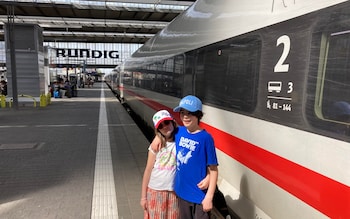
The route from St Pancras to Munich, via Frankfurt, and onwards to Slovenia offers a sense of adventure
Credit: Rosa Silverman
Hoping to double-dose on the romance, I make my way to the restaurant car for a spot of lunch before Frankfurt. But an unapologetic member of on-board staff informs me lunch is off. An energy failure, apparently.
She offers us an unappetising choice of cold sandwiches instead: vegan “chicken”, or something called “vollkorn haferbrötchen” containing slippery cheese, which will have to suffice.
On our third and final train of the day, from Frankfurt to Munich, I compensate by ordering at random from the restaurant car menu: chips, a cinnamon bun, tomato soup. It’s not quite a meal but represents a step up from British train fare, and being waited upon as we travel feels like being in an Agatha Christie novel.
To my surprise, everything remains on track, timing-wise. We pull into Munich 10 hours after leaving St Pancras, hot and triumphant.
It’s an unseasonably balmy spring evening, and we’re further rewarded for our efforts by the splendour of our accommodation here: the sumptuous Charles Hotel. Just a five-minute walk from the station, and overlooking Munich’s tranquil Old Botanical Garden, The Charles is the ideal place to stop.
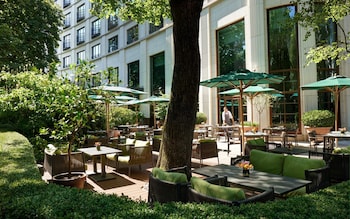
The Charles Hotel in Munich is a ‘sumptuous’ place to stay
Credit: Janos Grapow
It’s hard to believe we’re minutes from the heart of a bustling city. Standing at an open window, I luxuriate in the calm, gulping down the remarkably clean air. After a day spent on trains, it’s the perfect tonic.
The serenity extends to The Charles’s spa, and at the superlative breakfast in its delightful ground-floor restaurant, awash in bright sunlight.
We spend a delightful day exploring Munich, starting with the imposing gothic Frauenkirche cathedral. From here we wander to Marienplatz, the teeming central square, before stopping at the vast, open-air Viktualienmarkt for juicy bratwurst tucked inside crusty white rolls and slathered with thick yellow mustard. In theory, I don’t eat meat, but there’s only so many bratwurst vendors a pescatarian can pass on a glorious day. My resolve crumbles by lunchtime.
The Englischer Garten is so packed with afternoon sun-worshipping revellers, it resembles a music festival more than a park. A similarly lively atmosphere pervades the cavernous Hofbräuhaus later, where beer is served in stein glasses as big as your head and the vibe is peak Bavarian beer hall. Even if there’s a sense of performance about the whole thing, it’s still immensely enjoyable.
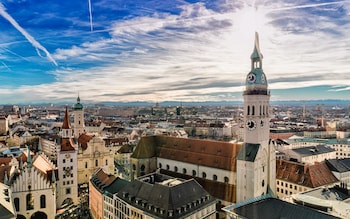
The family had fun exploring Munich (pictured) before heading to their next stop, Villach in Austria
Credit: Getty
The next day it’s time to reboard the trains, and on we go to Villach in Austria. Barely half an hour from Munich, snow-capped peaks appear on the horizon. Presently, large white Alpine-style chalets, complete with wooden balconies, begin to dot the dandelion-pocked meadows. The occasional cow grazes in a garden.
The train itself is decidedly more basic this time and stiflingly hot. I stagger through jolting carriages in search of refreshment, eventually locating a uniformed man arranging the contents of a snack trolley.
“Is there a dining car?” I ask.
“No. Trolley.”
“Will you be bringing it down the train?”
“No.”
He seems displeased by my intrusion, and even more so by my attempt to purchase some coffee and poppy seed cake.
This is more than compensated for by the increasingly dramatic scenes beyond the window: vertiginous snow-dusted mountains now, with dark pines clinging to their lower contours.
After five hours we arrive in Villach, a nine-minute interchange to contend with. We hurry between platforms in a panic, boarding our train to the Slovenian town of Jesenice just in time. Thrillingly, we snag a compartment on this one. Hot and stuffy, but ours for the next 36 minutes.
Then, at Jesenice, things slightly fall apart. I had assumed we would deduce how to reach Lake Bled upon arrival, given that it’s only 10 miles away. There are bound to be taxis, I thought. Except there are none. It is Sunday and nothing at the station is open either.
After some fruitless waiting, we discover there’s in fact a train to Lesce-Bled station.
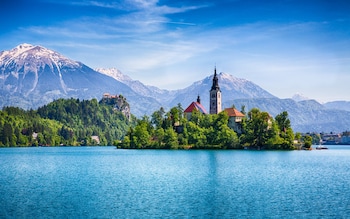
There is a train from Jesenise to Lesce-Bled station, where Lake Bled awaits the rail tourist
Credit: Moment RF/Getty Images
Here, an obliging station barman calls us a cab to our Airbnb, while we sit in the still-intense evening sunshine drinking iced tea on the terrace of his bar.
Lake Bled woos me instantly with its fairy tale charm. With the 17th-century Church of the Mother of God situated on an island in its centre, and Bled Castle perched on a cliff high above the clear water, the views in every direction take one’s breath.
The final leg is a bus to Ljubljana, less than an hour from Bled (but cash only, and appearing almost 30 minutes late). Clambering down at the other end, I enjoy a moment of relief tinged with disbelief: we’ve made it all the way here without missing a train or leaving the ground.
We’re staying at the InterContinental Ljubljana, where the windows in our spacious eighth-floor rooms overlook a spectacular panorama: the city beneath us, and the rugged Julian and Kamnik Alps that encircle it beyond. From the 18th-floor spa and 20th-floor restaurant, the views are even more intoxicating. It’s almost impossible to tear ourselves away.
Fortunately, it could hardly be easier to get around the sights of this charming and attractive city on foot – or on one of the Kavalir electric golf buggies, which cart tourists around for free.
The hotel is just a short walk from the pedestrianised Old Town, a perfect gem of urban design owing much to the classical-inspired vision of the Slovenian architect Jože Plečnik.
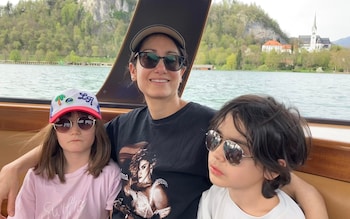
Rosa and her family were charmed by Lake Bled’s beauty
Credit: Rosa Silverman
There’s much to admire beyond the architecture, too. We start with Ljubljana Castle. A couple of minutes up the hill in a slick funicular, and we’re inside the grounds of the 900-year-old complex.
The children are won over by the immersive 4D film inside, which brings the castle’s story to life with the aid of special effects: spray on our faces for rain; shaking seats for added drama. From the castle tower, we enjoy another set of dizzying views.
Back on street level, we wolf down goulash at a cafe under the arches beside the Ljubljanica River, both banks of which teem with restaurants and bars, connected by a succession of scenic bridges.
In the unlikely event one tires of Ljubljana, Slovenia’s diminutive size means you can reach just about anywhere from the capital. We’ve been told we must see the caves, so, the next day, we jump on a bus to Postojna Cave Park.
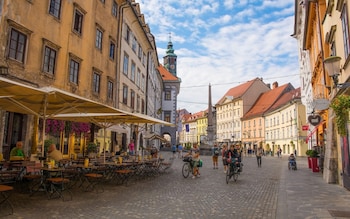
The attractions of pedestrianised Ljubljana were a hit with the children
Credit: Getty
A subterranean train carries us into a magical kingdom of vast underground chambers, one of which is so large it plays host to concerts. There’s an easy walkway through this incredible landscape of stalagmites and stalactites, which take on almost hallucinatory shapes.
We round off our stay in Ljubljana with a morning in the stunning Tivoli Park, where manicured lawns give way to hiking trails. Then we head to the airport. Yes, the airport. Overland was an adventure. But in a one-week holiday, doing it once the difficult way was enough.
Rosa Silverman and her family were guests at The Charles Hotel in Munich and at InterContinental Ljubljana, an IHG Hotels & Resorts property. Overland trips from Britain to Slovenia can be booked via Rail Europe.



